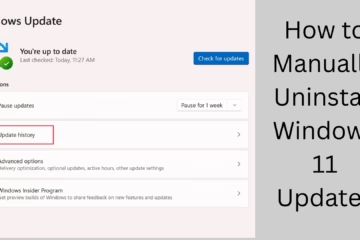Screen flickering can be a common problem for Windows 11 users. This problem can be caused by both hardware and software reasons, such as driver issues, display settings, and external devices malfunctioning. If your screen is flickering or blinking frequently, the 10 effective solutions provided in this article can help you.
1. Find the problem using Task Manager
First, we need to determine whether the problem is software-related or hardware-related.
How to check?
1. Open Task Manager by pressing Ctrl + Shift + Esc
2. If Task Manager runs normally and the screen is flickering, the problem may be caused by a third-party app or driver.
3. If the Task Manager is also flickering, the problem is probably related to the display driver.
2. Update the display driver
Often, an outdated or corrupt graphics driver causes this problem.
How to update:
1. Open Device Manager by pressing Windows + X.
2. Click on Display adapters and select your graphics driver (Intel, NVIDIA, or AMD).
3. Right-click and select the “Update driver” option.
4. Click on “Search automatically for drivers” and install the update.
5. Restart the system.
3. Reinstall the display driver
If updating does not resolve the issue, it may be necessary to uninstall and reinstall the driver.
How to uninstall:
1. Open Device Manager.
2. Under Display adapters, right-click on your graphics driver and select Uninstall device.
3. Restart Windows, which will automatically reinstall the driver.
4. Change high refresh rate settings
Incorrect refresh rate can also cause screen flickering.
How to change?
1. Open Settings by pressing Windows + I.
2. Go to System > Display > Advanced display.
3. Set the Refresh rate to 60Hz or higher.
4. Apply the changes and check if the issue is resolved.
5. Remove unnecessary external devices
Sometimes, monitor, keyboard, or USB devices can cause the issue.
How to check?
1. Remove all external devices (monitor, keyboard, mouse).
2. Reconnect one by one and see which device is causing the issue.
6. Check Windows Update
Microsoft fixes many issues through new updates.
How to?
1. Go to Settings > Windows Update.
2. Click “Check for updates” and install available updates.
3. Restart the system.
7. Quit the Insider Program (if joined)
If you are part of the Windows Insider Program, you may receive unstable updates that may cause the issue.
How to quit?
1. Go to Settings > Windows Update > Windows Insider Program.
2. Click “Stop getting preview builds”.
8. Create a new user account in Windows
Damaged profile settings can also cause this issue.
How to create a new account:
1. Go to Settings > Accounts > Family & other users.
2. Click “Add account” and follow the instructions.
3. Log in under the new user to see if the issue is resolved.
9. Turn on the device in Safe Mode
Safe Mode may make it easier to find out the actual cause of the issue.
How to do?
1. Press Windows + R, type msconfig, and press Enter.
2. Go to the Boot tab, select Safe boot, and apply.
3. Restart the system and see if the screen flickers.
10. Use System Restore If the above methods do not solve the problem, System Restore may be a better option.
How to do it?
1. Search and open “Create a restore point” by pressing Windows + S.
2. Click System Restore and select an earlier restore point.
3. Complete the process by pressing Next > Finish and restart the system.
Conclusion
If your Windows 11 screen is flickering, these 10 methods may solve your problem. Driver updates, changing settings, removing external devices, and Windows updates are some of the main solutions. If the problem persists, System Restore may be the last resort.
Want to grow your business organically? Contact us now
Windows 11 Screen Flickering FAQs
1. What is screen flickering?
Screen flickering occurs when the screen shows frequent flickering, blinking, or distortion. This problem can be caused by both hardware and software reasons.
2. Why does screen flickering occur in Windows 11?
Some of the main reasons for this are:
Outdated or corrupted display driver
Hardware or cable problems
Incompatible software or third-party applications
Incorrect refresh rate settings
Glitches caused by Windows updates
3. How to identify the problem via Task Manager?
1. Open Task Manager by pressing Ctrl + Shift + Esc.
2. If only the desktop or apps are flickering and the Task Manager looks normal, it may be a problem with a third-party app.
3. If the Task Manager is also flickering, the problem may be related to the display driver or hardware.
4. How do I update the display driver?
1. Open Device Manager by pressing Windows + X.
2. Go to Display adapters and right-click on your graphics driver.
3. Click Update driver and select Search automatically for drivers.
4. Windows will update the driver and then restart the system.
5. Can a wrong refresh rate cause screen flickering?
Yes, if your screen’s refresh rate is too low or inconsistent, it can cause flickering. To fix it:
1. Go to Settings > System > Display > Advanced display settings.
2. Set the Refresh rate to 60Hz or higher.
3. Apply the changes and see if the issue is resolved.
6. How to update Windows to stop screen flickering?
1. Go to Settings > Windows Update.
2. Click Check for updates.
3. If any update is available, install it and restart the PC.
7. Can changing the external monitor or cables solve the issue?
Yes, if the problem is hardware-related, then:
Replace the HDMI/DisplayPort/VGA cable
Test by connecting a different monitor
If the second monitor works fine, the problem may be with your monitor
8. Can third-party apps cause screen flickering?
Yes, some third-party apps and antivirus software can cause this issue.
To fix it:
1. Go to Settings > Apps > Installed apps.
2. Uninstall recently installed suspicious apps.
3. Restart the PC and see if the issue is resolved.
9. How to check screen flickering by going into Safe Mode?
1. Press Windows + R, type msconfig, and press Enter.
2. Click on Boot > Safe boot and click on Apply.
3. Restart the PC.
4. If the issue doesn’t occur in safe mode, then the problem might be with a third-party app or driver.
10. How to fix flickering with System Restore?
1. Press Windows + S, search and open “Create a restore point”.
2. Click on System Restore.
3. Select an earlier restore point and click on Next > Finish.
4. Restart the system and check if the issue is resolved or not.












